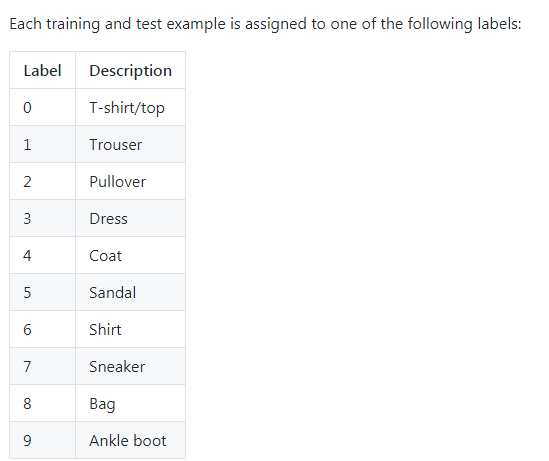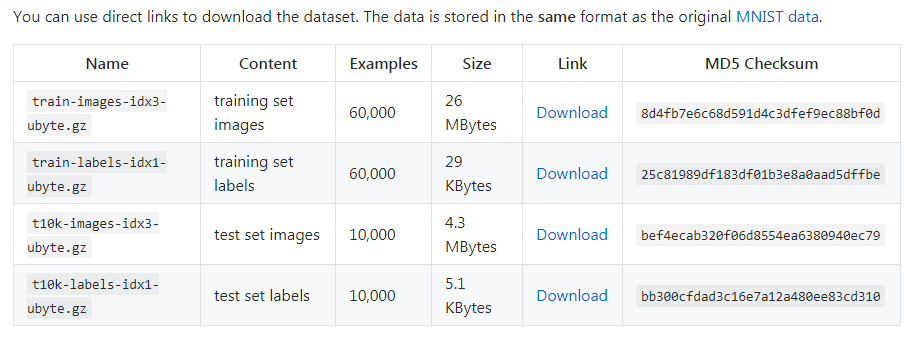mnist的数据预处理
mnist包含了0,1,2,3,4,5,6,7,8,9十个手写字体的image,大小为28*28*1。
mnist数据集在现在的image classification起的影响越来越小的。因为其数据量小,类别少,分类简单,一直没法能够作为算法比较的有效对比数据集。但是这个算法在debug 的时候还是有着很重要的角色。
mnist的source: http://yann.lecun.com/exdb/mnist/
下载可以得到四个文件。

为了更好的展示data,将mnist弄成 image 和 text label的形式。(使用Python (Numpy))
import numpy as np
import struct
from PIL import Image
import os
def train():
data_file = './train-images.idx3-ubyte'
data_file_size = 47040016
data_file_size = str(data_file_size - 16) + 'B'
data_buf = open(data_file, 'rb').read()
magic, numImages, numRows, numColumns = struct.unpack_from('>IIII', data_buf, 0)
datas = struct.unpack_from('>' + data_file_size, data_buf, struct.calcsize('>IIII'))
datas = np.array(datas).astype(np.uint8).reshape( numImages, 1, numRows, numColumns)
label_file = './train-labels.idx1-ubyte'
label_file_size = 60008
label_file_size = str(label_file_size - 8) + 'B'
label_buf = open(label_file, 'rb').read()
magic, numLabels = struct.unpack_from('>II', label_buf, 0)
labels = struct.unpack_from('>' + label_file_size, label_buf, struct.calcsize('>II'))
labels = np.array(labels).astype(np.int64)
datas_root = './mnist_train'
if not os.path.exists(datas_root):
os.mkdir(datas_root)
for i in range(10):
file_name = datas_root + os.sep + str(i)
if not os.path.exists(file_name):
os.mkdir(file_name)
train_x = []
train_y = []
for ii in range(numLabels):
img = Image.fromarray(datas[ii, 0, 0:28, 0:28])
label = labels[ii]
file_name = datas_root + os.sep + str(label) + os.sep + 'mnist_train_' + str(ii) + '.png'
img.save(file_name)
train_x.append( file_name )
train_y.append( label )
with open('./mnist_train.txt', 'w') as f:
for i in range(len(train_x)):
f.write( str( train_x[i] ) + ' ' + str( train_y[i] ) + '
' )
print('Done')
def test():
data_file = './t10k-images.idx3-ubyte'
data_file_size = 7840016
data_file_size = str(data_file_size - 16) + 'B'
data_buf = open(data_file, 'rb').read()
magic, numImages, numRows, numColumns = struct.unpack_from('>IIII', data_buf, 0)
datas = struct.unpack_from('>' + data_file_size, data_buf, struct.calcsize('>IIII'))
datas = np.array(datas).astype(np.uint8).reshape( numImages, 1, numRows, numColumns)
label_file = './t10k-labels.idx1-ubyte'
label_file_size = 10008
label_file_size = str(label_file_size - 8) + 'B'
label_buf = open(label_file, 'rb').read()
magic, numLabels = struct.unpack_from('>II', label_buf, 0)
labels = struct.unpack_from('>' + label_file_size, label_buf, struct.calcsize('>II'))
labels = np.array(labels).astype(np.int64)
datas_root = './mnist_test'
if not os.path.exists(datas_root):
os.mkdir(datas_root)
for i in range(10):
file_name = datas_root + os.sep + str(i)
if not os.path.exists(file_name):
os.mkdir(file_name)
test_x, test_y = [], []
for ii in range(numLabels):
img = Image.fromarray(datas[ii, 0, 0:28, 0:28])
label = labels[ii]
file_name = datas_root + os.sep + str(label) + os.sep + 'mnist_test_' + str(ii) + '.png'
img.save(file_name)
test_x.append( file_name )
test_y.append( label )
with open('./mnist_test.txt', 'w') as f:
for i in range(len(test_x)):
f.write( str(test_x[i]) + ' ' + str(test_y[i]) + '
' )
print('Done')
if __name__ == '__main__':
train()
test()
print('Done')
不过,最近出了一个新的类似mnist的数据集 fashion-mnist
source: https://github.com/zalandoresearch/fashion-mnist
fashion-mnist包含了十个现实生活中的物体,总的来说分类难度会比mnist较大。

继承了mnist的基本特性,fashion-mnist也是相同的数据存放格式。
